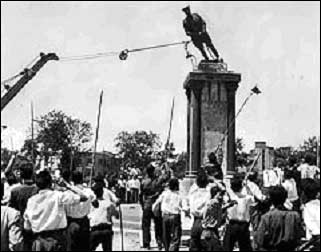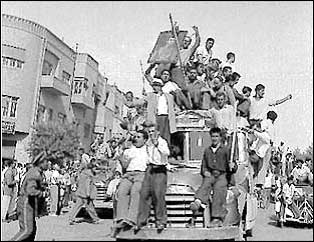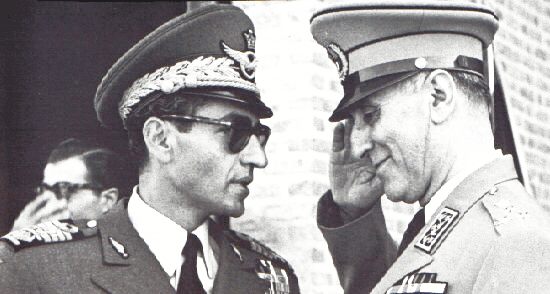"Operation Ajax"
|
Step 2: Turning now to a key primary source about
the coup, examine the following background information to the 1954 CIA
document dubbed the "Wilber report" that was kept secret until leaked to the New York Times in 2000, then read the excerpt
of the document itself below. |
|
|
|
At first the coup attempt went very
badly for the Shah, who fled to Baghdad on August 16th and to Rome
two days later; in this photo, taken on the 17th or 18th,
anti-Shah protestors probably associated with Iran's communist party (the Tudeh) are tearing down a statue of Reza Shah, the Shah's
father and founder of the Pahlavi dynasty. |
|
|
|
|
Dr. Donald N. Wilber (1907-1997), a CIA spy in Iran
working under the cover of an expert in Persian architecture. |
Supporters of the Shah carrying a
picture of him as they ride a commandeered bus in Tehran on August 19, 1953,
when the tide turned and the CIA-instigated coup overthrew Iran's
democratically-elected Prime Minister Muhammad Mossadeq. |
BACKGROUND TO
THE WILBER REPORT: The CIA history of Operation
TPAJAX, the original term for what became known simply as AJAX, was long kept
hidden from public view. James Risen first disclosed the material
excerpted here in The New York Times in
its editions of April 16 and June 18, 2000. This extremely important document is one of the last
major pieces of the puzzle explaining American and British roles in the August
1953 coup against Iranian Prime Minister Muhammad Mossadeq.
Written in March 1954 by Donald Wilber, one of the operation's chief
planners, the document is an after-action report based in part on agency cable
traffic during the operation and Wilber's interviews with agents who had been
on the ground (as he himself also was) in Iran as the operation unfolded.
The Wilber report is all the more valuable because
it is one of the relatively few documents that still exists after CIA
operatives destroyed an unknown quantity of materials&emdash;reportedly "routinely"&emdash;in
the 1960s, according to former CIA Director James Woolsey. This excerpt begins
with a document at the end of the report listed as Appendix A: "Initial Operation Plan for TPAJAX," comprised of notes
from a meeting of key operatives from the CIA and SIS (Britain's "Secret Intelligence
Service," commonly known as MI6, "Military Intelligence, Section 6") in June
1953 prior to the coup that spells
out the planning process; and the first three parts of the report entitled "Summary," "Preliminary Steps," and "Drafting the Plan" (36 pages total). The
plan was to have the Shah issue a firman, or
imperial decree, removing Mossadeq as Prime Minister
and replacing him with the pro-Shah (and staunchly anti-communist) General Fazlollah Zahedi, a move requiring a majority vote of the
Iranian Parliament (the Majlis). However,
Mossadeq found out about it and gathered his
supporters to defend him (as they had done the previous year). On the 18th
events were clearly in Mossadeq's favor, with the
Shah fleeing to Rome and anti-Shah protesters filling the streets of Tehran,
but the next day brought a dramatic turn of events in favor of coup planners.
As you read the excerpt, REMEMBER THAT THE AUTHOR DONALD WILBER IS NOT AN UNBIASED
OBSERVOR BUT A PARTICIPANT WITH A CLEAR POINT OF VIEW, namely that Mossadeq was bad and that thus the coup was justified. He ignores
the fact that Mossadeq was Iran's democratically-elected
leader and greatly overestimates the popularity of the Shah and General Zahedi
among the common people, as well as the links between Mossadeq
and Iran's communist Tudeh (which means "the masses")
party. Mossadeq had indeed lifted the ban on the
communist party in Iran, which should, after all, be allowed to operate freely
in a truly democratic society (as was more-or-less the case in the US at the
time), but he had also rebuffed Soviet efforts to gain a foothold over Iranian
oil fields in the country's north; had remained neutral in the Cold War; and
was staunchly nationalistic and definitely not
a communist himself (he did not want to see the Soviets dominate Iran and its
oil fields any more than he wanted to see the British or US dominate his
country). Some of the names in the document have been redacted. A Key is included for people and terms referred
to in the document whose identity or meaning may not be clear so refer to that
as necessary. Also key passages from later chapters of the report are excerpted
and included at the end as well (feel free, of course, to peruse the entire
document, a link for which is provided).
Finally, remember that unlike the secondary sources
examined in Step 1 of this assignment, the Wilber report is a primary
source, a source produced at the time of the event being studied (or, at
least in this case, very soon thereafter). In
analyzing all sources historians must ask three main questions: 1) Who
is the author? Dr. Donald Wilber, an obviously very biased CIA operative and key eyewitness and participant in the
events described. 2) Who is the
intended audience? This document was kept secret by the CIA for forty-six
years before being leaked to the New York
Times, so obviously the intended audience was not the broader American (or Iranian) public, but rather a small
group of CIA agents, operatives, and bosses. 3) What was the author's intention in writing this document?
As clarified in a 1969 CIA publication of the Wilber report for agency use only "it
seemed desirable to have a record of a major operation prepared while documents
were readily at hand and while the memories of the personnel involved in the
activity were still fresh" and also some of the lessons learned in this
operation may prove "applicable to future, parallel operations."
|
|
|
The Shah of Iran (left) with
General Fazlollah Zahedi (right) in the 1950s, not
long after the coup that overthrew Mossadeq and replaced
him with the more compliant Zahedi&emdash;a former Nazi collaborator during World
War II&emdash;as Iran's Prime Minister. |
Be prepared to identify at least one aspect of the report you find particularly interesting or surprising. After reading the report, return here and move on to Step 3 below.



